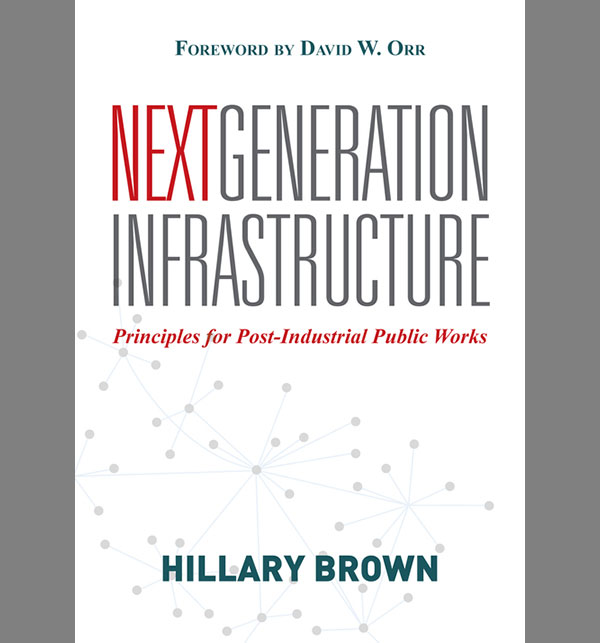
Next-Generation Infrastructure: Principles for Post-Industrial Public Works ã (Island Press, 2014)
Synergy. A simple word that is commonly used in theô world today. A world that keeps us to overcome physicalô distances, andô facilitatesô the collaboration between different fields and sectors through new technologies. But is it truly being utilized?
In her newest book, Next-Generation Infrastructure: Principles for Post-Industrial Public Works, Hillary Brown confronts this question head on. How are we to expand and move onward in a world that demands this of its resources when our systems are complex and antiquated? How will these systems fair against climate change? Will they help or hinder the process of decarbonization? These are just a handfulô of the tough questions addressed within.
The one thing that was certain after reading the book is that there is no clear answer to the collection of queries the world is presenting. But there are paths that we can begin to establish that willô lead us to a more positive future. A future within whichô a synergistic infrastructural systems approach will undoubtedly be a key factor.
Every point made in the book was meticulous and bore a strong connectionô to current and future problems being faced around the world. The short form, and a paraphrasing of the first chapter, is that we need to be bold in our actions. Whether we are looking at issues of drought, flooding, coastline resiliency, or public awareness, every topic that the book chose to embrace was relevant and purposeful.
There are frightening statistics (ãThe United States loses 1.7 trillion gallons of drinking water annually through system leakage and 240,000 water main breaks per year.ã) contrasted with hopeful yet realistic methods and models for change (ãThe alternative paradigm proposed in this volume calls for more diversified, distributed, and interconnected infrastructural assets that simulate the behavior of natural systems.ã), all while maintaining five tenements of which these next-generation infrastructures are based:
- Systems should be multipurpose, interconnected, and synergistic
- Infrastructure should contribute few or no carbon emissions
- Infrastructure should work with natural processes
- Infrastructure should improve social contexts and serve local constituencies
- Infrastructure should be resilient and adapt to predicted changes brought about by an unstable global climate
According to Brown, infrastructural projects of the past maintained their ãspecialistã ability and worked for one goal – doing it well. Unfortunately, as we progress and our demands grow, these single-use piecesô of our society are no longer able to maintain their output in an ecologically friendly way. We are damming more rivers, displacing silt and eroding shorelines; we are burning more fossil fuel to keep up with demand, causing a failure to meet key climate figures that we (no matter the nation) have pledged to uphold; we are not planning for an adaptive future, where resiliency is our first priority. Furthermore, quick fixes often cost us more in the long-termô than reinventing some systems from the ground up, and Brown does an exemplary job highlighting these facts.
While the book is heavily focused on U.S. infrastructure, the basic lessons apply to any nation seeking a more plausible future in terms of their reliance on natural systems and man-made infrastructure. The question that one often returns to is why we seem to have difficultyô changing? What impassable roadblocks seem to confront us so profoundly that change is seems never to be an option?
Brown, too, points out the often quoted ãBusiness As Usualã approach to life and attributes it to one of the main reasons change isnãt being driven. The question still remains though of how to force a wedge in between this thought process, and Brown raises an interesting concept of weaving the general populous back into these infrastructural programs in order to transparently show people how change is occurring and allow regular individuals the opportunity chance to see why making a change is imperative, if we wish to jump tracks to a more positive plan for our future.
However these questions are ultimately answered, our Next-Generation Infrastructure will undoubtedly need to meet the concepts laid out by Brown. ô Not merely because of her background and expertise, but because it has become a running theme throughout many different publications and lectures that society needs to be included again. We can no longer sit back and hope for changes to happen. Instead, we collectively must be invested in our municipalities and their plans for our infrastructural futures. It is now common knowledge that we must cut carbon emissions drastically. But we must also rekindle the social integration that makes us such a strong and resilient species.
While simple and accessible, Next-Generation Infrastructure: Principles for Post-Industrial Public Works offers greatô insight into a sector of our world that needs one of the largest overhauls.
***
For more information on the book, visit the Island Press website.
**
Jeremy Senko is happily lost in the world of theoretical architecture and design. He is forever a student at heart, consistently reading, experiencing and learning about the world he inhabits. More specifically, he recently completed his Bachelor of Interior Design at Kwantlen Polytechnic University, where he pushed the limits (and the patience) of his professors.


